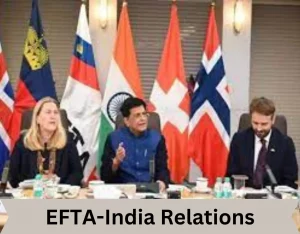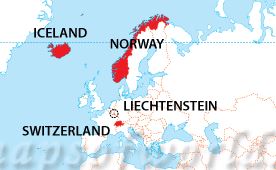ForumIAS announcing GS Foundation Program for UPSC CSE 2025-26 from 19 April. Click Here for more information.
Recently, India-EFTA relations are moving ahead as India has resumed negotiations with EFTA(European Free Trade Association) for a Trade and Economic Partnership Agreement (TEPA). However, EFTA’s demands for inclusion of ‘Data exclusivity‘ and ‘Specific duration’ clauses in the agreement have been a sticking issue in the negotiations. India has argued that these provisions will adversely impact the Indian generic drug industry. EFTA-India
What is EFTA? What is Trade and Economic Partnership Agreement (TEPA)?
| About | It is an intergovernmental organization established in 1960 through the Stockholm Convention. |
| Objective | To facilitate free trade and economic integration among its members, both within Europe and on a global scale. |
| Members | Iceland, Liechtenstein, Norway, and Switzerland |
| Function | 1. The organization works alongside the European Union (EU). 2. Unlike the European Union (EU), it does not function as a customs union. 3. All four member states participate in the European Single Market through European Economic Area (EEA) Agreement. |
Trade and Economic Partnership Agreement (TEPA)
The TEPA is a comprehensive agreement that covers trade in goods, trade in services, investment, intellectual property rights, competition, government procurement, trade facilitation, trade remedies, dispute settlement, and other areas of mutual interest.
Objective
1. It aims to eliminate/reduce tariffs and non-tariff barriers on a wide range of products. It will create opportunities for trade and investment between India and EFTA.
2. It aims to ensure fair and transparent market access conditions for service providers and investors. It will also enhance cooperation on intellectual property rights protection and enforcement.
3. TEPA aims to establish effective mechanisms for dispute resolution.
What is the Significance of EFTA for India?
1. Deep Economic Relations-
a. EFTA is India’s 9th largest trading partner, accounting for about 2.5% of India’s total merchandise trade in 2020-21.
b. The main items of India’s exports to EFTA are textiles, chemicals, gems, and jewellery, machinery, and pharmaceuticals.
c. The main items of India’s imports from EFTA are machinery, chemicals, precious metals, and medical instruments.
2. Innovation and Competitiveness- EFTA nations are leaders in innovation and competitiveness. EFTA companies are world leaders in pharmaceuticals, biotechnology, machinery manufacturing, R&D-driven technology products, geothermal-related technologies, marine technology, energy-related services, financial services, banking, and insurance.
3. Success History of EFTA’s Trade Agreements- FTAs with EFTA have been favourable for other countries of the world. 29 free trade agreements (FTAs) with the EFTA are currently in operation.
4. Support of India’s permanent membership of UNSC-The EFTA countries recognise the growth of India as a world leader and support India’s permanent membership of UNSC.
What are the benefits of free trade agreement between India-EFTA?
1. Increase in Trade Opportunities- A free trade agreement between India and EFTA would lead to increased trade opportunities for India. For ex- It would give India market access to high per capita European countries.
2. Increase in Investment- It would give a further push to EFTA investments, which is around $35 bn in sectors such as machinery, electrical engineering and metals, pharmaceuticals, banking, financial services and insurance, construction, and fast-moving consumer goods (FMCG)
3. Enhanced cooperation in service sector- A free trade agreement between India-EFTA would give a further push to the services sector cooperation. It would create more business opportunities for skilled Indian service providers.
4. Push to Green energy sector in India- EFTA countries are leaders in green energy. EFTA states can help India to meet its green growth aspirations of 50% renewable energy by 2030, with their cutting-edge technologies.
5. Promotion of Democratic values- Deeping of economic cooperation between India and EFTA states would further promote the shared democratic values such as sustainable development, inclusive growth and gender equality.
What are the Challenges in India-EFTA Relations?
1. Data exclusivity and specific Duration Clauses – Data exclusivity safeguards the clinical trial information of a pharmaceutical company, about a particular medication. During the exclusivity period, generic competitors cannot use the originator’s data to get approval for similar drugs.
These provisions would promote monopolization for foreign pharmaceutical companies and would be a setback for the Indian generic industry. This will also lead to a rise in the cost of affordable medicines in India.
2. Differences in Economic Structures – Bridging the differences in the economic interests of different economic structures of India (developing country with low per capita) and EFTA countries (developed economies with high per capita income) is a formidable challenge.
3. Intellectual Property Rights Protection – Challenge of protection of IPR of the EFTA companies engaged in pharmaceuticals, biotechnology, and machinery manufacturing.
4. Market access challenges – There are issues regarding tariffs, quotas, and non-tariff barriers which are hindering the free market access between the two parties. Further, there are wide-ranging differences in regulations, standards, and legal frameworks.
| Read More- India rejects EFTA’s data exclusivity demand in trade talks |
What should be the way Forward?
1. Address the issue of data exclusivity- The high-level delegates from EFTA and India should work towards resolving outstanding issues such as data exclusivity, specific duration clauses, that hinder the conclusion of a mutually beneficial TEPA.
2. Identification of areas of Mutual Benefit- Both the parties should identify areas of mutual benefit, such as technology transfer, R&D and innovation. Cooperation must be enhanced in these mutually beneficial sector before the FTA is concluded.
3. Strong Political Involvement and Guidance- Strong political involvement and guidance must be provided for an early conclusion of the TEPA agreement between the two nations.
| Read More- The Hindu UPSC Syllabus- GS 2- India’s relations with developed economies |






